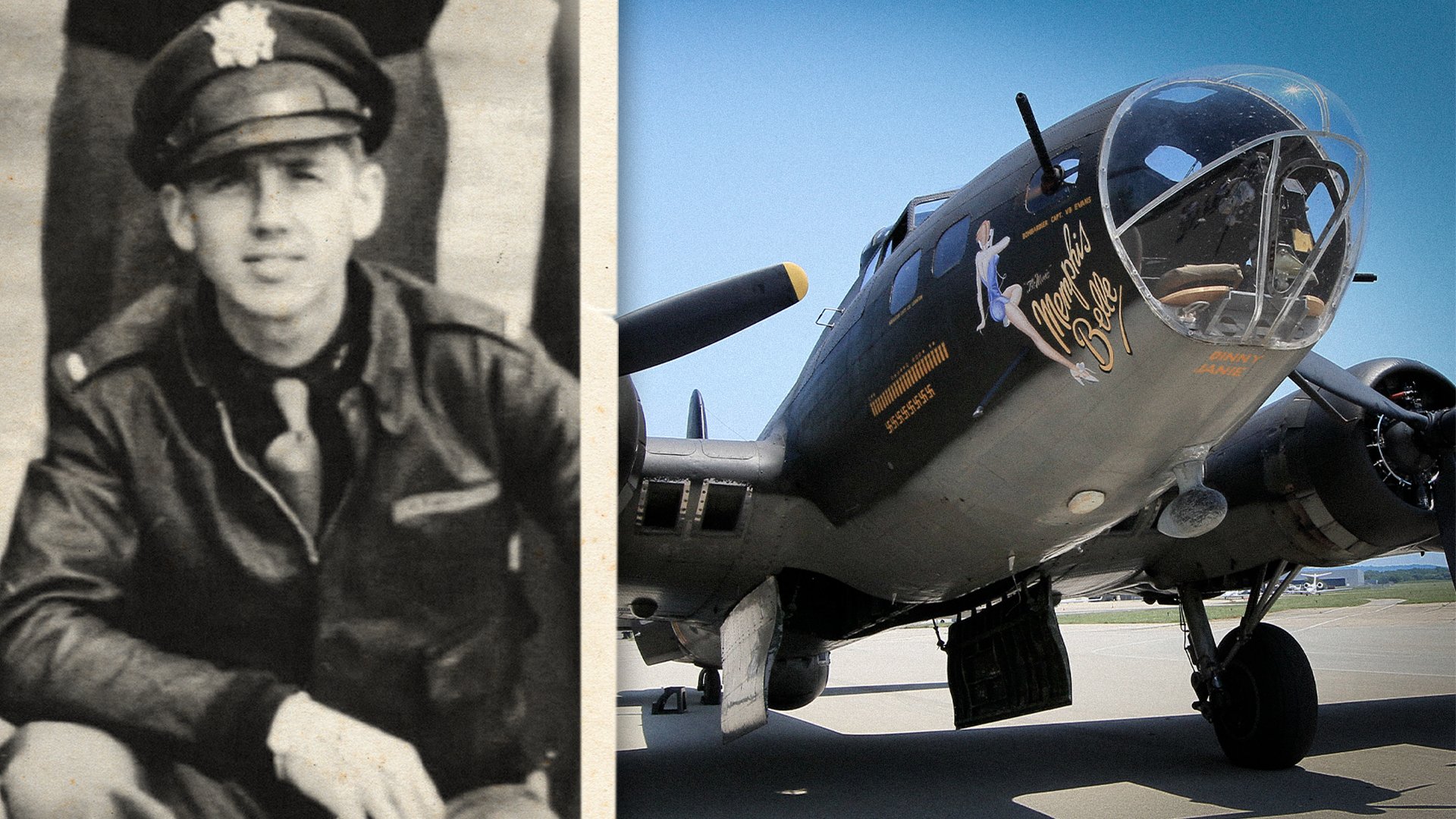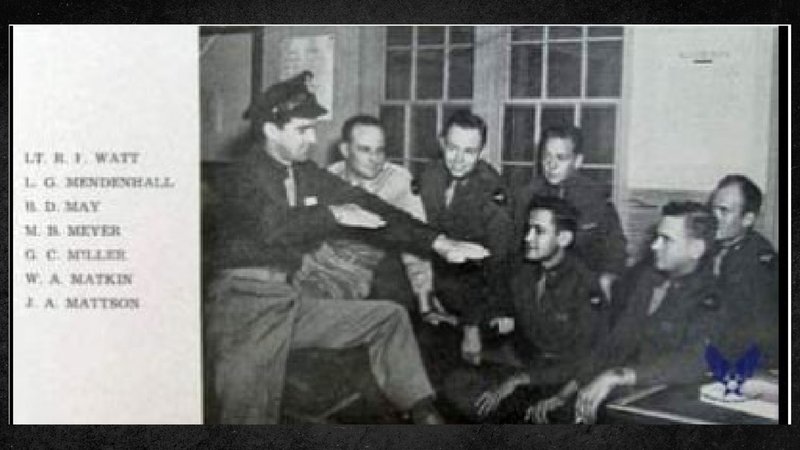Remains of B-17 Bombardier, Killed a Week Before D-Day, Head Home at Last

US Army Air Force 1st Lt. Melvin B. Meyer, 25, of Pattonville, Missouri, was killed during World War II. His remains were officially identified on Sept. 9, 2022. Composite by Kenna Lee/Coffee or Die Magazine.
The family of a B-17G bombardier, who was thought to have died when his plane was shot down in 1944, is making plans to lay their ancestor to rest 79 years later.
On Tuesday, Jan. 17, the Defense POW/MIA Accounting Agency announced they accounted for US Army Air Forces 1st Lt. Melvin B. Meyer on Sept. 9, 2022.
“For them to bring him home after all these years is incredible,” Meyer’s great-nephew, Jim Crum, 68, told Coffee or Die Magazine.
Crum said Meyer is slated to be buried in a marked tomb in Jefferson Barracks National Cemetery in St. Louis, Missouri, in May before Memorial Day.

Formation of the Flying Fortresses of the 91st Bomb Group, 8th Air Force, en route to the target of the day. National Archives photo.
During World War II, Meyer was assigned to the 569th Bombardment Squadron, 390th Bombardment Group, 13th Bombardment Wing, 8th US Army Air Force. He was a part of a bombing mission over Leipzig, Germany, on May 29, 1944.
His bomber, serial number 42-39953, had been rechristened twice before it was named “Yankee Doodle Dandy.” Previously, and under records released to Coffee or Die Magazine by Jim Bell, an identification specialist with the Past Conflict Repatriations Branch in Fort Knox, Kentucky, it went by “Dutch Cleaner.” And then “Flying Coffin.”
The plane was ambushed by German Air Force — Luftwaffe — fighters, caught fire, and came crashing down 28 miles northeast of the German city.
Six crew members parachuted to safety, including copilot 2nd Lt. Robert E. “Bob” Patterson, radio operator Staff Sgt. Weldon A. Pillow, waist gunners Staff Sgt. Lester A. Miller and Staff Sgt. William J. “Bill” Striffler, tail gunner Staff Sgt. Joe Finch, and Staff Sgt. George Hauskins. All became prisoners of war.

The Defense POW/MIA Accounting Agency determined that US Army Air Forces 1st Lt. Melvin B. Meyer, 25, of Pattonville, Missouri, was killed during World War II, and his remains were officially identified on Sept. 9, 2022. Defense POW/MIA Accounting Agency photos.
The plane crashed near Horst and the remaining four crew members — 1st Lt. Carl D. Nesbitt, navigator 2nd Lt. Wayne L. Dyer, bombardier Meyer, and Tech. Sgt. Lyle L. Larson, the engineer and top turret gunner, were thought to have died on impact. The bodies were buried in a local cemetery.
Crum was told the prisoners of war said in their debrief that Meyer was last seen helping the gunner, Larson, who had been wounded by a .22mm shell, don his parachute.
“It’s sad that four more men lost their lives over one man, but that’s the way it is,” Crum said. “‘There’s no man left behind’ type deal.”
Larson is the only crew member yet to be announced as identified by the Defense POW/MIA Accounting Agency.

Melvin B. Meyer is shown among fellow US Army Air Force service members. Photo courtesy of the Casualty and Mortuary Affairs Operations Center.
The American Graves Registration Command found remains of one of the crew members in September 1946, but when the Berlin Wall went up, the Soviet Union prevented further investigation of the cemetery.
The young World War II bombardier was declared non-recoverable on April 21, 1953.
DPAA’s predecessor organization, the Joint POW/MIA Accounting Command, discovered the crash site in July 2012. In 2019, the DPAA contracted History Flight, Inc., to excavate.
The remains discovered were sent to the DPAA Laboratory at Offutt Air Force Base, Nebraska, for scientific analysis. DPAA scientists used dental and anthropological analysis, as well as circumstantial and material evidence, while scientists from the Armed Forces Medical Examiner System used mitochondrial DNA analysis.

The Defense POW/MIA Accounting Agency determined that US Army Air Forces 1st Lt. Carl D. Nesbitt, 23, of Lima, Ohio, was killed during World War II, and his remains were officialy identified on Sept. 9, 2022. Defense POW/MIA Accounting Agency photos.
Crum commended the teamwork it took to find his great-uncle’s body.
“I think a whole bunch of his story is the people that went through trying to find him and how that located him,” Crum said. “As a civilian, I have no idea that this kind of stuff is going on. It goes on every day.”
Of the three Meyer brothers, Melvin and Caesar enlisted while Harold stayed home. Caesar was sent to war in the Philippines and made it back home, while the family only knew that Melvin’s plane did not return from a mission.
“They went all this time without knowing what happened to the brother, but I’m sure they knew,” Crum said. “Particularly my one uncle who went to the Philippines, because he knew what war was all about.”

The Meyer Bros. truck delivered ice and coal around Overland, Missouri, before Melvin and Caesar Meyer left for war in 1944. Photo courtesy of Jim Crum.
Melvin Bernard Meyer was born on March 2, 1919, in Overland, Missouri, to Anna and Henry Meyer.
Crum said he learned the most about his uncle through stories his grandmother, Elsa Meyer, would tell him.
“Stories came through her and she would always say, ‘I loved the other two brothers. I would have loved to have met the third one because they were both characters.’”
Melvin, she said, was the most handsome and the “biggest character,” Crum said.

Boeing B-17 Flying Fortress of the 91st Bomb Group, 8th Air Force, wing their way over enemy territory en route to the target in Brunswick, Germany. Jan. 30, 1944. National Archives photo.
“She would have loved to have been alive to hear that he was finally found,” Crum said.
Before the two brothers’ enlistments, Crum said, “the brothers had their own little business going.” The three ran Meyer Brothers and would deliver coal and ice “and stuff like that.”
The trio also had two sisters, Florence and Alice.
Melvin married his wife, Vivian, before he went to war, and the two had a daughter, Marilyn.

First Lt. Melvin B. Meyer, 569th Bombardment Squadron, 390th Bombardment Group, 13th Bombardment Wing, 8th US Army Air Force, is shown with his wife, Vivian, left, and gathering flowers, right. Photos courtesy of Casualty and Mortuary Affairs Operations Center. Composite by Noelle Wiehe/Coffee or Die Magazine.
“I’m not sure whether or not he had ever seen her, which is a shame,” Crum said.
After the war, both Vivian and Marilyn lived with Melvin’s family in Overland, Missouri, on Eminence Avenue.
Meyer’s name is still etched on the Tablets of the Missing at the Henri-Chapelle American Cemetery, an American Battle Monuments Commission graveyard in Hombourg, Belgium.
But workers affixed a rosette next to his name, indicating that he’d finally been found.
Read Next: USS The Sullivans: The Tragic Story Behind the Name

Noelle is a former staff writer for Coffee or Die through a fellowship from Military Veterans in Journalism. She has a bachelor’s degree in journalism and interned with the US Army Cadet Command. Noelle also worked as a civilian journalist covering several units, including the 75th Ranger Regiment on Fort Benning, before she joined the military as a public affairs specialist.
BRCC and Bad Moon Print Press team up for an exclusive, limited-edition T-shirt design!
BRCC partners with Team Room Design for an exclusive T-shirt release!
Thirty Seconds Out has partnered with BRCC for an exclusive shirt design invoking the God of Winter.
Lucas O'Hara of Grizzly Forge has teamed up with BRCC for a badass, exclusive Shirt Club T-shirt design featuring his most popular knife and tiomahawk.
Coffee or Die sits down with one of the graphic designers behind Black Rifle Coffee's signature look and vibe.
Biden will award the Medal of Honor to a Vietnam War Army helicopter pilot who risked his life to save a reconnaissance team from almost certain death.
Ever wonder how much Jack Mandaville would f*ck sh*t up if he went back in time? The American Revolution didn't even see him coming.
A nearly 200-year-old West Point time capsule that at first appeared to yield little more than dust contains hidden treasure, the US Military Academy said.












